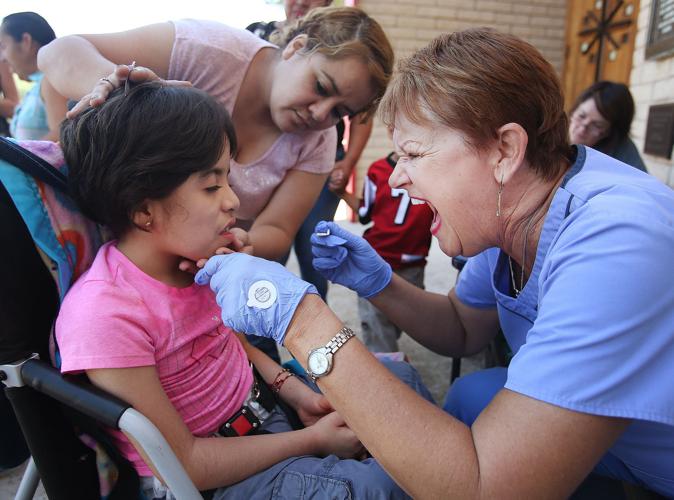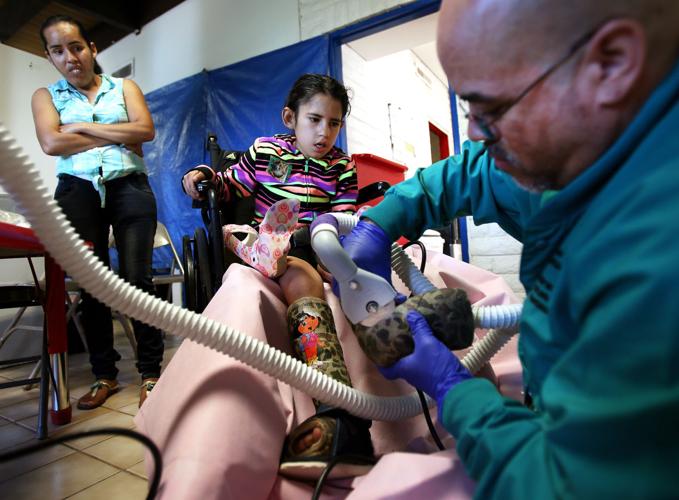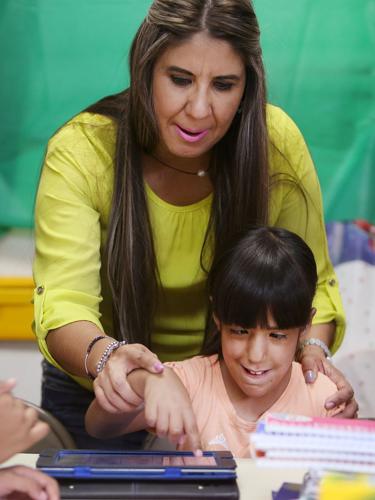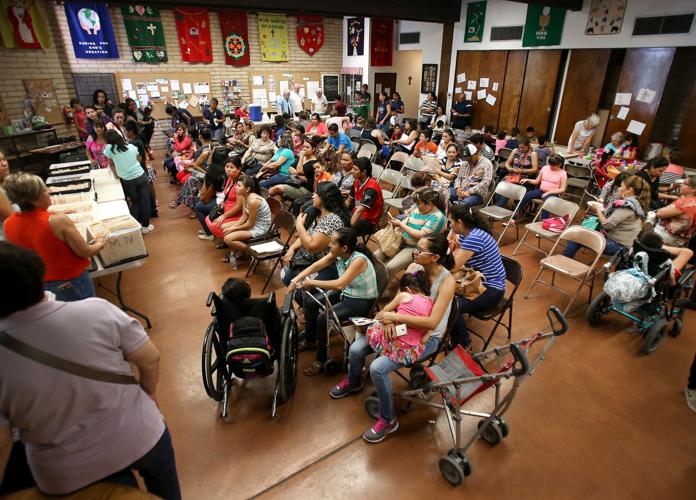NOGALES, Ariz. — The dirt parking lot around St. Andrew’s Episcopal Church bustles with activity, but it isn’t Sunday and these are not your typical parishioners.
A man directs traffic while throwing a baseball to laughing children who dodge puddles from the latest rain. Other children, many in wheelchairs or walking on prosthetic legs plastered with cartoon images, gather with their parents in the muggy shade around the church.
It’s the first Thursday of the month, and the volunteer-run St. Andrew’s Children’s Clinic is open for business.
In its 44th year, the clinic provides free medical services to children who live in Mexico and cannot afford or access the care they need.
Medical personnel see up to 250 children in a day, helping with nutritional supplements, physical therapy, glasses, corrective shoes, hearing aids, wheelchairs, walkers, prostheses and referrals to partner hospitals for those who need surgery.
“Depending upon what the child’s needs are, a child may see more than one health care practitioner in a day,” said Vicki Fitzsimmons, a retired professor who devotes 10 to 30 hours every week to clinic business.
Inside the church, every pew is full and the nave is bustling with children and their parents —what several long-time volunteers lovingly call “organized chaos.” Hallways branching off the middle of the church are full, too, and lead to doctors treating their young patients.
Sandra Lopez, 10, sits quietly in a wheelchair while one of her two Dora the Explorer casts is carefully cut off her leg and foot.
Sandra was born with a bone deformity in both legs that caused her to walk on her toes. She received a referral to the Shriners Hospitals for Children in Spokane, Washington, where she stayed for a little over a month and had surgery on her Achilles tendons.
From surgery to shoes, the clinic takes care of a wide range of issues. When Sandra first came to the clinic eight months ago, her shoes were worn-out from walking on her toes.
“She and her mother were so thrilled for her to have a new pair of shoes,” Fitzsimmons said. “It was one of those miracles we see here.”
“It just changes
their world”
Narrow brick hallways lined with tables covered in “Cars” and “Monsters, Inc.” tablecloths offer bowls of nachos and homemade muffins, while other tables hold arts-and-crafts supplies. In the kitchen, women chat as they prepare the communal lunch.
It seems every room in the church houses a different medical department, including audiology, augmentative/alternative communication, dermatology, nutrition, occupational therapy, orthotics and prosthetics, pediatric orthopedics, physical therapy, speech and language therapy, and vision.
Inside the pediatric orthopedic department, children and their parents wait patiently while others lay on the beds as they get checked by their doctors, including pediatric orthopedic surgeon Glen Baird.
As part of his job with Shriners Hospitals for Children in Spokane, Baird assesses patients for surgery and does post-op follow-ups, accompanied by two registered nurses and one cast technician/licensed practical nurse, also from the hospital.
The Children’s Clinic pays for transportation to the Shriners hospitals in Spokane and in Sacramento, California, for children who need surgery and an accompanying parent. The hospitals perform the surgeries at no cost and host the child and parent as long as necessary, whether it be days, months or even the occasional year, depending on the severity of the condition and recovery time.
Since Dec. 3, 2015, nine doctors from Shriners in Spokane performed 324 surgeries on 140 patients. Baird, who has been coming to the clinic every other month since October 1999, said he works with the clinic because he loves it.
Next to the Spokane crew, explaining the results of an X-ray to a young girl’s parents, is Tucson pediatric orthopedic doctor Francisco Valencia, who began volunteering at the clinic with his mother 42 years ago, at the age of 15, as an interpreter. Working at the clinic is the best part of his month, he says.
As a teenager, he began cutting class to volunteer at the clinic because he was learning more there than at his high school, he says. Those early experiences at the clinic were a huge influence on his life and career.
“Children that come and get a pair of glasses, it just changes their world, and that’s something that’s really important for a community like Nogales,” he said. “They’re tied at the hip and you cannot ignore what’s going on across the border. If the children are growing up healthy, it really does have an impact on how we live here on this side.”
The majority of patients live in Nogales, Sonora, but some come from as far away as Mexico City.
“They ride the bus overnight with a child with disabilities. They don’t have money to get back. They don’t have money for food,” Valencia said. “It’s a testament to the dedication the families have, the faith that they have in what we’re trying to do for them, that they are willing to take a risk and come up and put themselves in our hands.”
400 permits a month
Many patients and their parents receive one day visas through U.S. Customs and Border Protection. If they need to remain longer in the U.S. for surgery, longer stays are arranged. Coca Romero, patient coordinator for the clinic, often secures 400 permits a month for the children and a parent.
For Romero, getting the needed permits is easy, she says. Like many who help at the clinic, she has been doing it for decades. She brought her son with cerebral palsy as a patient 44 years ago.
Tania Ontiveros Cortés has been bringing her son Jonathan Córdovo Ontiveros, 16, to the clinic for 12 years, traveling more than three hours from Hermosillo.
Jonathan has cerebral palsy, and the clinic has provided him with language therapy, nutrition counseling, wheelchairs, orthopedic services, regular check-ups to assess his progress and physical therapy, including teaching him to chew his food better.
“We have received so much help,” Ontiveros Cortés said. “We are so grateful to all the people. We really value the effort, the donations, all the volunteers, their willingness and dedication.”
“Grass-roots effort”
The clinic has between 40 to 50 volunteer medical staff and 35 to 50 additional volunteers who act as interpreters, board members, receptionists, kitchen staff, record keepers, set-up and take-down crew and drivers.
“This is a model that has worked for 40 years,” Valencia said. “It’s a grass-roots effort. Everything we do is by word of mouth. It’s by volunteering.”
Run on donations from all over the country, the clinic has three paid full-time staff and one part-time member, with about 98 percent of donations spent on patient care. Executive director Laura Romero, introduced to the clinic as a patient when she was 4 years old, raises the $400,000 yearly budget through grant writing and presentations about the clinic, recruiting individual donors.
Recent large donors include the White Elephant Thrift Store in Green Valley, which donated $65,000 in December, and the Benchmark Foundation of Tubac, which donated $8,500 in July. Money is also raised through small fundraisers, which typically bring in $3,000 to $5,000.
“Every penny counts,” Romero said. “Spreading the word about the clinic is what really helps. It’s very important that we get our word out there that we’re here and what we’re doing.”







